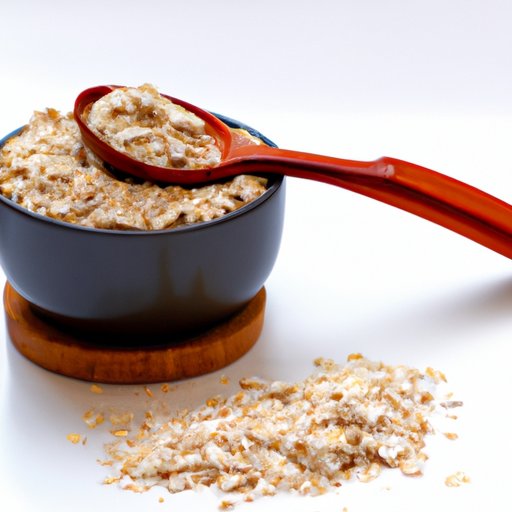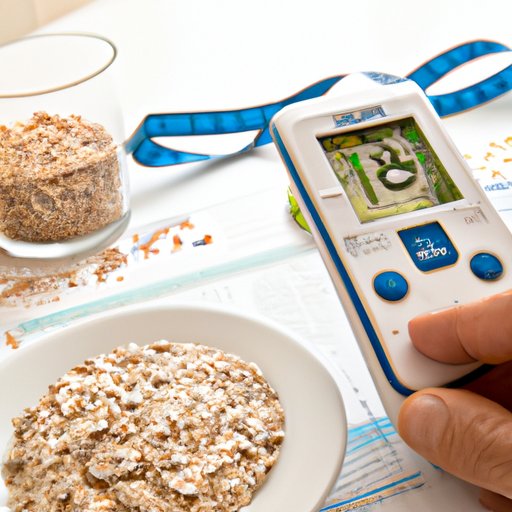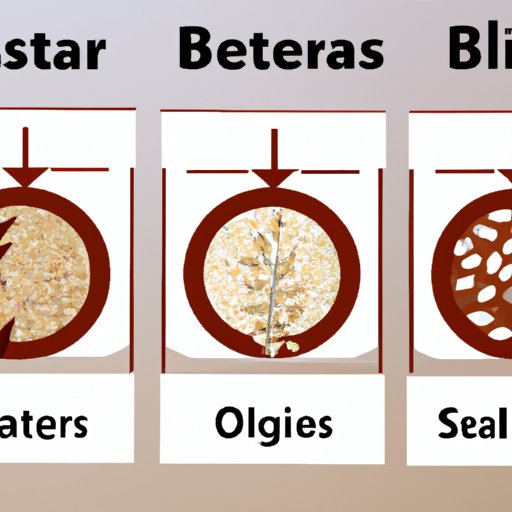Introduction
Diabetes is a chronic condition that affects millions of people around the world. It requires careful management in order to keep blood sugar levels within a healthy range. For people with diabetes, it’s important to make informed decisions about their diet in order to maintain their health. One food that is often recommended for people with diabetes is oatmeal.
Oatmeal is a popular breakfast food that is packed with nutrients and has a low glycemic index. It is high in fiber and provides many essential vitamins and minerals. In this article, we will explore why oatmeal is a good choice for diabetics and discuss its nutritional value, types of oatmeal, and how to use the glycemic index to choose the right oatmeal for you.

Exploring the Health Benefits of Oatmeal for Diabetics
Oatmeal is a great choice for people with diabetes because it offers several health benefits. It is high in fiber, which helps to slow digestion and keep blood sugar levels steady. It is also rich in vitamins and minerals, including iron, magnesium, zinc, and B-vitamins.
Oatmeal is also a low glycemic index food, meaning it is digested slowly and does not cause sudden spikes in blood sugar levels. This makes oatmeal a great choice for people with diabetes who need to manage their blood sugar levels.

Analyzing the Nutritional Value of Oatmeal for People with Diabetes
Oatmeal is a nutrient-dense food that provides many essential vitamins and minerals. Here is a breakdown of the macronutrients and micronutrients found in one cup (160 grams) of cooked oatmeal:
- Calories: 166 calories
- Protein: 5 grams
- Carbohydrates: 27 grams
- Fiber: 4 grams
- Fat: 3 grams
- Vitamin A: 2% of the RDI
- Vitamin C: 0% of the RDI
- Calcium: 4% of the RDI
- Iron: 10% of the RDI
As you can see, oatmeal is an excellent source of vitamins and minerals. Not only are these nutrients essential for overall health, but they can also help to regulate blood sugar levels. For example, vitamin D is known to improve insulin sensitivity, while magnesium helps to reduce inflammation and stabilize blood sugar levels.
What Type of Oatmeal is Best for Diabetics?
When it comes to choosing the best type of oatmeal for diabetics, there are three main options: steel cut oats, rolled oats, and instant oats. Each type has its own unique nutritional profile and glycemic index.
Steel Cut Oats: Steel cut oats are made from whole oat groats that have been cut into smaller pieces. They have a chewy texture and nutty flavor. Steel cut oats are high in fiber and have a lower glycemic index than other types of oats.
Rolled Oats: Rolled oats are made from whole oat groats that have been steamed and flattened. They have a softer texture than steel cut oats and a milder flavor. Rolled oats are high in fiber and have a moderate glycemic index.
Instant Oats: Instant oats are pre-cooked and dried, making them fast and easy to prepare. They have a soft texture and mild flavor. Instant oats are lower in fiber and have a higher glycemic index than steel cut or rolled oats.
Examining the Glycemic Index of Oatmeal and How It Affects Blood Sugar Levels
The glycemic index (GI) is a measure of how quickly a food raises blood sugar levels. Foods with a low GI (55 or less) raise blood sugar levels more slowly than foods with a high GI (70 or higher). The GI of a food can vary depending on the type of oatmeal and how it is prepared.
For example, steel cut oats have a GI of 42, while rolled oats have a GI of 55. Instant oats have a higher GI of 66. These numbers indicate that steel cut oats have the lowest impact on blood sugar levels, followed by rolled oats, and then instant oats.
It is important to note that the GI of a food is not the only factor to consider when choosing oatmeal. Other factors such as the amount of carbohydrates, fiber, and fat in the food can also affect blood sugar levels.
Discussing Portion Control and How to Eat Oatmeal with Diabetes
It is important to practice portion control when eating oatmeal, especially if you have diabetes. The American Diabetes Association recommends eating 1/2 cup of cooked oatmeal as a serving size. Eating too much oatmeal can cause blood sugar levels to spike, so it is important to pay attention to how much you are eating.
In addition to portion control, there are other tips for eating oatmeal with diabetes. For example, adding nuts or seeds to your oatmeal can help to slow digestion and keep blood sugar levels steady. You can also add low-fat milk or yogurt to your oatmeal for a boost of protein and calcium.

Comparing Different Types of Oatmeal and Their Impact on Blood Sugar Levels
When it comes to choosing the best type of oatmeal for diabetics, it is important to consider the glycemic index as well as the nutritional content of each type of oatmeal. Here is a comparison of steel cut oats vs. rolled oats, and instant oats vs. steel cut oats:
- Steel Cut Oats vs. Rolled Oats: Both types of oats are high in fiber and have a low glycemic index. However, steel cut oats are slightly lower in carbohydrates and have a lower GI than rolled oats.
- Instant Oats vs. Steel Cut Oats: Instant oats are lower in fiber and have a higher GI than steel cut oats. They are also higher in carbohydrates and fat.
Conclusion
Eating oatmeal can be beneficial for people with diabetes. Oatmeal is a nutrient-dense food that is high in fiber and provides essential vitamins and minerals. It is also a low glycemic index food, meaning it is digested slowly and does not cause sudden spikes in blood sugar levels.
When choosing the best type of oatmeal for diabetics, it is important to consider the glycemic index as well as the nutritional content. Steel cut oats are the best choice, followed by rolled oats and then instant oats. It is also important to practice portion control and eat oatmeal in moderation.
By following these tips, you can enjoy oatmeal as part of a healthy, balanced diet for diabetes. With the right choices, oatmeal can be part of a nutritious meal plan that supports your health and helps to keep your blood sugar levels in check.
(Note: Is this article not meeting your expectations? Do you have knowledge or insights to share? Unlock new opportunities and expand your reach by joining our authors team. Click Registration to join us and share your expertise with our readers.)
